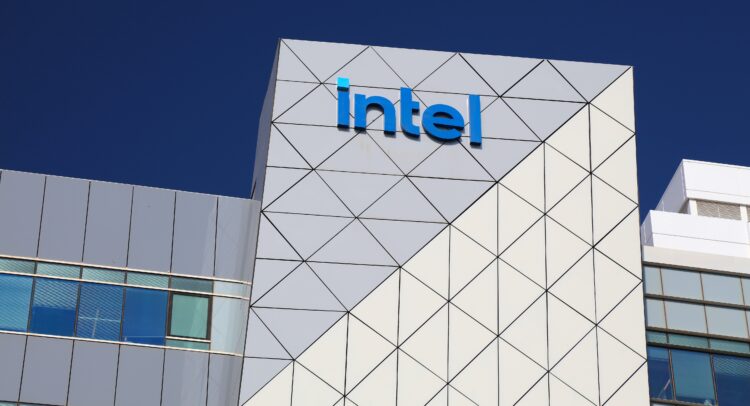Intel Corporation (INTC), a leading global chipmaker, has lost 60% of its market value in the last five years as the company failed to mitigate threats posed by rivals such as Nvidia Corporation (NVDA) and Advanced Micro Devices, Inc. (AMD). According to Bloomberg, the company faces a fresh challenge in the form of new export restrictions. Despite this, I remain bullish on Intel as I believe Intel is cheaply valued today due to its renewed focus on AI chips.
Confident Investing Starts Here:
- Quickly and easily unpack a company's performance with TipRanks' new KPI Data for smart investment decisions
- Receive undervalued, market resilient stocks straight to you inbox with TipRanks' Smart Value Newsletter
Intel Faces New Export Sanction Threats
Intel has faced several regulatory challenges in the recent past, including export restrictions to China. These headwinds have led to a $500 million reduction in the company’s third-quarter revenue guidance, reflecting the importance of major Chinese chip buyers like Huawei. While these sanctions present serious challenges, I remain bullish on Intel because I believe these issues may be temporary. In fact, the company has a history of navigating complex regulatory environments.
Despite my optimistic outlook, more salt was added to Intel’s wound when, on Oct. 15, Bloomberg reported that U.S. officials discussed tightening sales of advanced AI chips from major American chip companies such as Nvidia and AMD using a country-specific model, which could limit some nations’ artificial intelligence capabilities. It would also force major chipmakers such as Nvidia, AMD, and Intel to strategize their plans to keep exports flowing without significant disruption.
According to Bloomberg, the new sanctions, if enacted, will target Middle Eastern nations such as Saudi Arabia and the United Arab Emirates. The objective behind this move is to limit chip exports to Russia and China from the Middle East. If enacted, the new sanctions would create a ceiling on export licenses. The Biden administration has already restricted AI chip exports of Nvidia and AMD to more than 40 countries across the Middle East, Africa, and Asia over fears their products could be diverted to China. The U.S. sees these export licenses as strong leverage for its global diplomatic goals.
China’s Growing Chip Independence May Threaten Intel
Although I am bullish on Intel due to its cheap valuation and long-term growth prospects as an AI chipmaker, I am keeping a close eye on the threat posed by China’s growing chip independence. Faced with U.S. export restrictions, Chinese tech companies are aggressively investing in the domestic production of advanced chips. The government is also supportive of this effort. In May, China’s Ministry of Industry and Information Technology issued a directive to fully remove foreign chips from China’s telecommunication networks by 2027. As part of this strategy, Chinese officials have prohibited state-owned enterprises from purchasing computers with foreign chips, encouraging them instead to buy products with chips developed by Huawei and HiSilicon.
In addition to Huawei and HiSilicon, several other chipmakers, including Tencent Holdings Limited (TCEHY), Shanghai Lumaotong Group, and China Mobile International, have stepped up to address chip shortages in China. If China’s efforts to achieve chip independence are successful, Intel stands to lose a significant portion of its revenue in the long run. For context, in 2023, Intel reported $14.85 billion in revenue from China, which accounted for more than 27% of the company’s total revenue.
Intel CEO Pat Gelsinger is not oblivious to the long-term threat posed by China’s growing chip independence. In June, during an interview at the 2024 Computex Taipei, Gelsinger emphasized the importance of making innovative Intel products, such as Gaudi, available to the Chinese market for the company to continue growing. He believes Intel’s technological lead over Chinese rivals, who currently lack adequate technologies, will give the company an edge. However, these competitive advantages may prove short-lived if new export restrictions from the U.S. government are imposed, potentially limiting Intel’s growth potential.
Intel Can Still Find Light at the End of the Tunnel
One of the main reasons behind my bullish stance on Intel is the company’s turnaround prospects. Intel’s operating margins are expected to improve significantly in the coming years, driven by the company’s latest cost-reduction plans. Last August, Intel announced a new initiative to save $10 billion by 2025, which includes reducing its workforce by 15%, or approximately 15,000 employees. These cost savings should enable Intel to accelerate investments in AI-related chips, positioning the company to compete more effectively with AI chip giant Nvidia as a more efficient business.
In addition to the anticipated operational efficiencies, Intel’s focus on enhancing its manufacturing capabilities through the IDM 2.0 program is encouraging. After a period of lackluster investments in new fab plants, Intel is once again aggressively investing in its manufacturing arm, which should help close the gap between itself and rivals like Taiwan Semiconductor Manufacturing Company Limited (TSM).
Moreover, Intel has unveiled an intriguing product lineup for the next couple of years, including Arrow Lake and Panther Lake processors. In terms of AI chip production, Intel is concentrating on advancing its 18A process technology. The Gaudi 3 Accelerator also has the potential to capture market share from AI chip leader Nvidia, as Gaudi 3 chips are priced competitively. Intel’s low-price strategy is particularly encouraging, as it could attract business from SMBs that are delaying AI investments due to the high price of Nvidia’s H100 and H200 chips.
Is Intel a Buy, According to Wall Street Analysts?
Despite Intel’s promising AI chip prospects, some Wall Street analysts remain cautious. For example, on Oct. 17, Goldman Sachs analyst Toshiya Hari cut his earnings estimates for the next Fiscal year by 7% due to the slow recovery of the PC market. The outlook for the PC market should be monitored closely, given Intel’s current heavy reliance on it.
Based on the ratings of 34 Wall Street analysts, the average INTC price target is $25.34, which implies upside of 11% from the current market price.


My bullish stance on Intel stems from the company’s cheap valuation. At a forward price-to-sales (P/S) multiple of 1.86, Intel is trading at a significant discount compared to its closest rival AMD, which trades at a forward P/S multiple of 9.85. Nvidia, on the other hand, is valued at a P/S multiple of 27. Although Intel has a lot of catching up to do, the company’s competitively priced new AI chips should help it gain traction in the next few years, making Intel’s valuation both cheap and attractive.
Key Takeaway
Intel is a victim of chip export restrictions, and the company is likely to face new export challenges in the coming months, according to Bloomberg. Although this risk needs to be monitored closely, the company seems attractively valued amid its focus on AI chips. The company’s cost reduction plans are also appealing, given their potential to boost operating margins.










